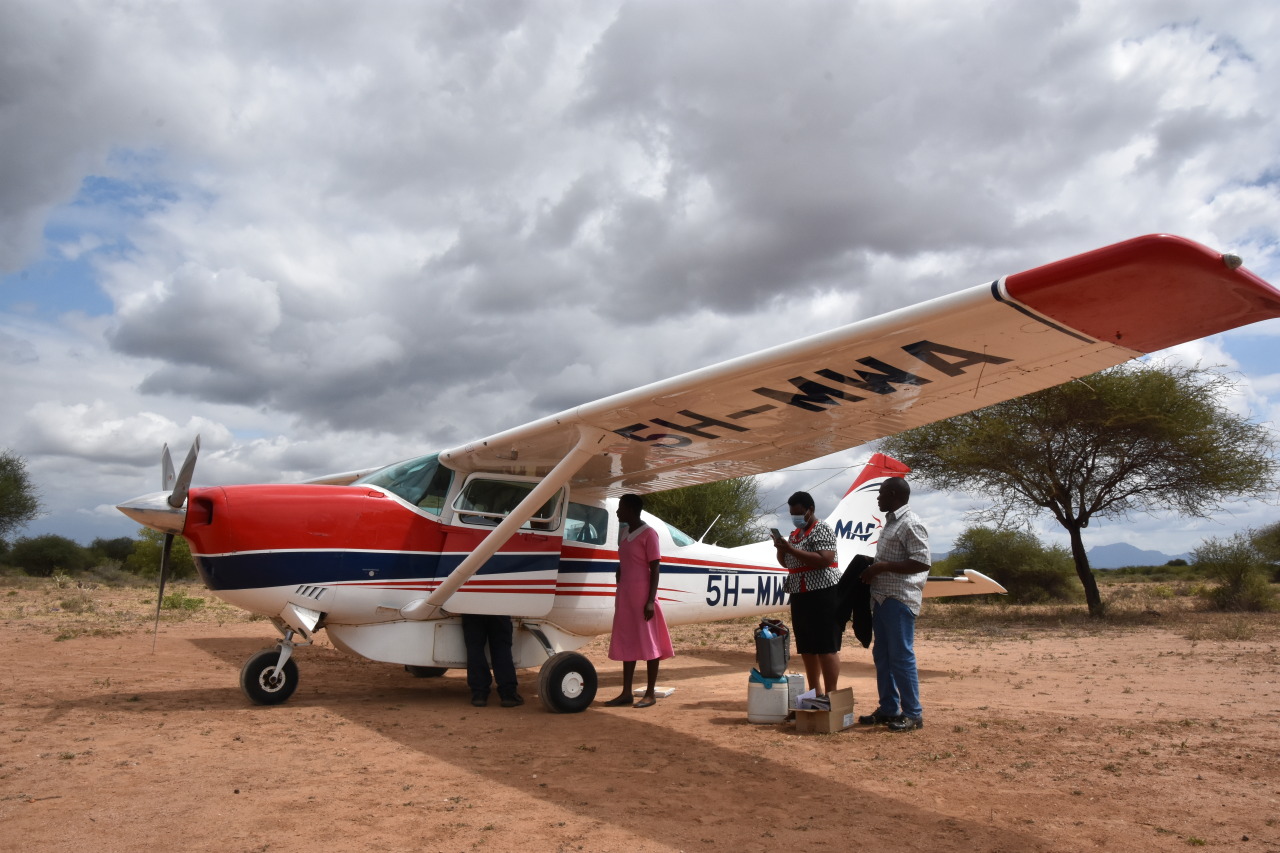A few years ago, a plane took off from Juba with three planned stops in different parts of South Sudan. On arrival at the first location, the grass was too long on the airstrip and the pilot could not land. People were actually cutting the grass. He decided to go to the next airstrip and it was flooded because of heavy rains that had earlier pounded the area. They could not land. Looking at his calculations, the pilot realized that there was too much weight on board to reach the third airstrip. He had expected to drop people and luggage at the first two airstrips. They ended up flying back to Juba without landing at any of the locations. The team that was being flown was frustrated because their plans had been thwarted.
“That’s the hardest thing to do as a pilot, making those tough decisions that safety comes before anything else. You really need to be careful. In this case it would have been risky to land in those locations. At the end of the day, they were grateful that we safely arrived back in Juba” says Daniel Loewen-Rudges who was flying a Cessna Caravan that day for Mission Aviation Fellowship.
His dream of becoming a pilot was sown when he was a young kid growing up in Mbeya, a town in South East Tanzania where his parents had moved to as missionaries from Canada. He was always fascinated by aircraft and the immaculately clad pilots in their striped uniforms and cool sunglasses. The landings and take offs at the airstrip in Mbeya, which were part of Mission Aviation Fellowship’s (MAF) operations in the area, stirred up a desire in him to become a pilot one day and fly with MAF.
10 years later his family relocated back to Canada for 4 years after which they moved to Kenya where Daniel finished his high school. He then went to Canada to finish his university studies, do flight training and then came back in 2006 to start flying with MAF.
We met at the MAF offices at Wilson Airport. Daniel’s office on the higher floor overlooks the hangar, a backdrop of planes, tug tractors, service stairs, maintenance equipment and spare parts reiterating the seriousness of MAF’s work. One dressed down plane was undergoing maintenance before a scheduled flight the following week to Loiyangalani.
Each part carefully inspected, the checklists strictly adhered to, the logs carefully entered, the engineers meticulous to the bone. It’s the efficiency and use of processes that keep them safe even though they operate in extremely challenging terrains.
Daniel, who now heads the operations of MAF in Kenya was simple and courteous, often smiling and dropping Swahili words at the end of conversations. He’s poised, unperturbed and carries an ease about him that perhaps comes with the territory of being a pilot.
“What was your role when you first joined MAF in 2006?” I ask.
“I was just a flying pilot. I flew a small 6-seater aircraft, Cessna 206, to places like Lodwar, Marsabit and did charters around Kenya supporting some of the organizations that we work with,” he responds.
“What is the most memorable place that you have ever landed?”
“There are places in South Sudan that you land and you feel like you are in the middle of nowhere. I think of places like Renk, in the northern end of South Sudan. To get there is very hard, the roads are poor so the only way is by air. On the ground in Renk, you just feel how isolated the people are. Exposure to the outside world is almost zero and there’s very little exposure to the gospel,” Daniel recalls.
“It is places like Renk that you realize how important it is to use the aircraft to get to some areas,” he continues
And that is where Mission Aviation Fellowship comes in.
MAF has operated in Kenya since 1959, serving remote communities through providing safe, secure flight services. They serve local church groups, missionaries, NGOs, and development and relief agencies who are working to provide access to healthcare, safe drinking water and the gospel to the isolated people groups. In Kenya, it is particularly in the North Eastern part of the country.
The ministry that was working in Renk (which is 3 hours by flight from Juba) needed MAF to help them get there because it would take them days by road, and if rains the roads are virtually impassable. And we haven’t even talked about security.
In the 50s and 60s MAF was already working in South Sudan. They have been in and out since then because of the conflict.
Mission to unreached groups
I was keen to hear Daniel’s comments on the general state of missions to unreached groups in Kenya, given his experience and reach on the ground.
He sighs and responds, “So, in Kenya you would say most places are churched, ‘everybody goes to church’, but that’s only a small part of the country, as soon as you head north of Isiolo, that’s not the case anymore. You do find missionaries working up there from some churches and ministries but it’s rare. I still think that Kenya is like two countries. You have the developed part and the part that’s been forgotten. Am talking about the northern and the eastern side. When it comes to the eastern side like Tana River, the gospel has not really reached. People have tried and they are making some inroads but the reality is that it’s very cut off. Mostly its people with Somali background there so its almost 100% Muslim with very little exposure to the gospel.”
“What do you think the church in Kenya can do to reach out to these groups?” I ask.
“This is something am very passionate about,” Daniel beams, excitedly. I had finally asked a question that mattered and I could see it in his face.
“This is something that we are really pushing for at the moment. The church in Kenya needs to take ownership of the situation in the Northern and Eastern part of the country. In the past missionaries were coming from outside but those days are kind of over. Nowadays there’s always less missionaries from outside which is good in a lot of ways, it shows that things are moving forward. But… who is filling that gap? The church in Kenya needs to step up a bit when it comes to that. A lot of churches would be involved in ministry around Nairobi and in major towns all the way up to Isiolo, and they end there.”
“We talk about reaching Jerusalem, Judea, Samaria and to the ends of the earth. I have seen Churches in Kenya go to Jerusalem and some even to the ends of the earth but somehow, they have missed Samaria. It’s like they have jumped it. It’s okay to start churches in big cities around the world, but let’s not forget Kenya. There’s a part of Kenya that’s still very isolated.”
Daniel acknowledges that there are physical challenges of getting to places in Turkana, Marsabit and other northern countries. And that’s where MAF comes in.
He would like to see members of churches, especially from Nairobi go out and experience what’s going on out there.
Talent Teams
One of the projects that MAF has pioneered and is pushing at the moment is called ‘Talent Teams’. The idea is basically to get members of churches to join a team that’ll go out and serve for a few days in a remote location, with a ministry that’s already there. MAF will provide the means of getting them there. They will see what’s actually going on and how they can use their gifts and talents to reach out and also how their churches can get involved to spread the Kingdom.
“Let’s partner with others, let’s try to get a few more people aware of what’s going on,” Daniel reiterates.
How MAF started
MAF started 75 years ago. After the 2nd world war, pilots who had been flying military aircraft decided to use their skills to serve Jesus. They began Mission Aviation Fellowship in the US and in England and it’s been growing since then.
In Africa, MAF has programs in Mozambique, Angola, Congo, Madagascar, Uganda, Tanzania, South Sudan and Liberia.
Worldwide MAF has operations in 30 countries, operating 130 aircraft and landing in more airstrips daily than any other airline in the world. That is landing in very remote, very short, isolated airstrips in places that no one else goes.
In Kenya MAF is licensed to fly humanitarian organizations, healthcare organizations and the church. World Vision, Mission of Hope, CURE and churches like Citam are some of the groups that MAF works with as well as medevac services for various healthcare organizations.
Back to Missions
I wasn’t done with the issue of missions. I wanted to squeeze a bit more out of a man who is not only passionate about reaching out but has first-hand experience of the need on the many grounds he has landed.
Daniel’s had more to say about it
“Obviously we shall always have intermingling in the kingdom of God, people coming from different places for a common mission. But the initiative has to come from within. And that involves resources and personnel.”
“I think the only way for churches to be motivated is to see. It doesn’t mean much to hear something or watch a video. But if you actually land in Loiyangalani and visit a local church, talk to the pastor, get to know the people there and understand their challenges, when you build friendships and have a relationship with the people, suddenly you are motivated to make a change and be involved. Seeing is really important,” he adds.
That’s the big thrust that pushes Daniel to do initiatives like Talent Teams. He has seen first-hand the encouragement that the local churches feel by the visits but he knows that those visits are more influential for the visitors who are often shocked to find out that they are still in Kenya. Those who are passionate and motivated will come back and share with others and that’s when a momentum will start building.
“Ministry needs to be multifaceted; urban, rural and overseas. When people say resources are limited, I tell you resources are there if people are motivated,” he says those words subtly but with weighty conviction.
Like the donkey in the story of the good Samaritan, Mission Aviation Fellowship provides the transportation services to those providing the help and those in need of the help.



